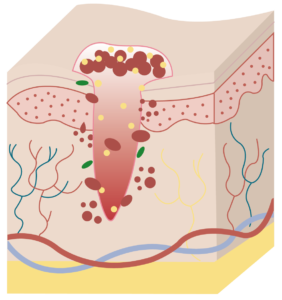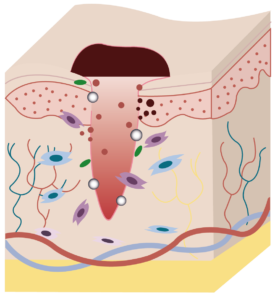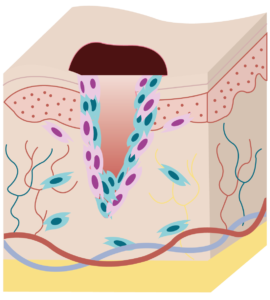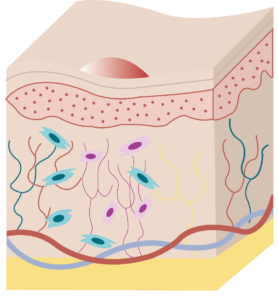THE FOUR STEPS OF THE SCARING PROCESS*
*Velnar T, Bailey T, Smrkolj V. The wound healing process: an overview of the cellular and molecular mechanisms. J Int Med Res. 2009 Sep-Oct
HEMOSTASIS

HEMOSTASIS: FIRST step of the scarring process
During hemostasis, blood vessels contract and platelets form a plug to stop bleeding. Inflammatory molecules and growth factors (proteins that stimulate the growth of specific tissues) are then produced to orchestrate the healing and repair process of the skin.
INFLAMMATION

INFLAMMATION : SECOND step of the scarring process
During inflammation, cytokines, molecules and growth factors orchestrate the molecular activities that lay the foundation for scar formation. This process activates the production of collagen and elastin, two vital components for damaged tissues’s reconstruction. While collagen acts as a structure and ensures the good resistance of the tissue, elastin is essential to ensure elasticity of the scar, and helps prevent an overly rigid scar.
PROLIFERATION

PROLIFERATION: THIRD step of the scarring process
The reconstruction of the tissue then further accelerates as cells further multiply themselves.
In order to obtain an aesthetic and sufficiently elastic scar, the concentration of the molecular healing actors must be appropriately regulated. Indeed, growth factors are key to ensure a good balance between the synthesis of :
– Collagen Type I, which is thicker and more rigid, and thus essential to restore the extra-cellular matrix
– Collagen Type III, which also contributes to restoring the extra-cellular matrix, but is a lot thinner and flexible than Collagene Type I, and hence essential to make the scar aesthetic and elastic.
– Elastin, which, as Collagen Type III, also participates to ensure the elasticity of the scar.
An imbalanced production between Collagen Type I and III, (overproduction of type I collagen), does not allow the scar process to take place in optimal conditions. In this case, there is a significant risk of getting an unsightly scar such as: a hypertrophic scar, a keloid scar, or other problematic scar symptoms.
maturation

MATURATION : fourth step of the scarring process
During maturation, scar tissue formed during the proliferation phase undergoes structural and organizational changes to strengthen and improve its functionality. Collagen fibers in the scar tissue continue to reorganize and strengthen, while vascularisation gradually decreases. The scar usually becomes flatter, softer and paler over time. This process can take several months to several years depending on the characteristics of the original wound and on the individuals.
